Zhu Dinghong and maintenance methods is Daquan Zhu Dinghong toxic?
Zhu Dinghong, also known as Baizhilian, Pillar Dinghong, Zhu Dinglan, Guting Flower, Huazi Orchid, Baizhilian, Baizhilian, Guihong, is a perennial herb of the genus Amaryllidaceae. Zhu Dinghong has many different varieties, with thick and glossy leaves, various colors, soft and gorgeous flowers, and large and fat flowers. It is suitable for potted plants to be displayed in living room, study and windowsill.
Morphological features:
The total pedicel of Zhu Dinghong is hollow, covered with white powder, with 2-6 flowers at the top, with trumpet-shaped flowers, flowering in late autumn and from spring to early summer, and even some varieties bloom from early autumn to Spring Festival (Burley). Most of the modern cultivated ones are hybrids with large flowers and bright colors, such as bright red, rose red, orange red, light red, white, blue-purple, green, white in powder, yellowish in red, etc., and their flower colors can cover all the other colors in the chromatography except pure blue, pure black and pure green. Those with large flower diameter can reach more than 20cm, and there are double varieties. The variety of Zhu Dinghong is not inferior to that of tulips; the variety of flowers is more complete than that of hyacinths; the pattern of flowers is peculiar and even lilies are inferior to lilies; the double art of flowers and leaves is rare.
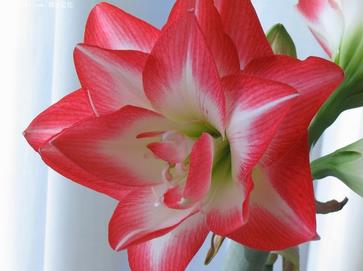
Common varieties:
The common cultivated varieties of Zhu Dinghong are:
1. Red lion (Redlion) with crimson flowers.
2. Hercules with orange-red flowers.
3. Rilona, with light orange-red flowers.
3. Communication satellite (Telstar), large flower species, bright red flowers.
4. The crown of flowers (FlowerRecord), with orange-red flowers with white broad longitudinal stripes.
5. Souvereign with orange flowers.
6. The goddess of wisdom (Minerva), with large flowers, red flowers and white hearts.
7. Picotee, the flowers are light green in white and red at the edge.
New varieties suitable for potted plants launched in Europe:
1. Las Vegas is a two-color variety of pink and white.
2. Calimero, a small flower with bright red flowers.
3. Amigo, late flowering species with crimson flowers, is considered to be the best potted variety.
4. Nagano, with orange-red flowers and snow-white hearts.
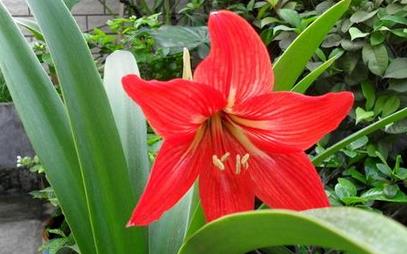
Application value:
Zhu Dinghong is mainly used as an ornamental. The red leaves of Zhu Ding are thick and glossy, the colors are soft and gorgeous, and the flowers are huge and thick. It is suitable for potted plants to be displayed in living room, study and windowsill.
In addition, Zhu Dinghong's bulb can also be used in medicine, which has the effect of promoting blood circulation and detoxification, dispersing blood stasis and detumescence, and can be used for the treatment of all kinds of nameless swelling, injury, blood stasis, redness, swelling and pain.
Distribution of origin:
Zhu Dinghong is native to Peru and Brazil and is widely cultivated in various countries.
Life habits:
Zhu Dinghong likes warm and humid climate, the suitable temperature for growth is 18 ℃-25 ℃, avoid extreme heat, the sun should not be too strong, should be maintained under the shade shed. I'm afraid of flooding. During the dormant period in winter, a cool climate should be 10 ℃-12 ℃, not less than 5 ℃. Like sandy loam rich in humus and well drained.
The breeding method of Zhu Dinghong is simple, in most cases, it can flourish if it is casually buried in the soil, and even the light ball forgotten in the corner can blossom tenaciously. It is very difficult to cultivate Zhu Dinghong, and it is often encountered in the cultivation of seed balls, such as fester, degradation, diseases and insect pests, especially the cultivation of imported balls, which needs to be treated more cautiously, otherwise, a brilliant flower may be silent for a long time. The following is a brief introduction to several key links of Zhu Dinghong planting:
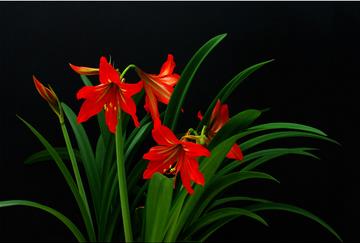
First, planting Zhu Dinghong
The suitable growth temperature of Zhu Dinghong is about 20-25 ℃, which can be used to determine the planting time. When planting potted plants at home, you can refer to the following steps:
(1) clean up the seeding ball. Cut off the rotten and dry roots of the bulbs and retain the remaining healthy roots. If there are multiple layers of brown dry outer skin on the outside of the seed ball, part of it can be peeled off to minimize the hidden danger of festering.
(2) planting balls to replenish water. If the seed ball loses more water due to a long storage period, it is best to replenish the seed ball, that is, soak the middle and lower part of the seed ball with water slightly higher than the ambient temperature for 1 or 2 hours, and those with experience can add some plant hormones such as gibberellin to the water. it is also beneficial to rooting and later bulb expansion, but we should pay attention to the concentration and soaking time, otherwise it will be self-defeating.
(3) disinfection. It is the key link of planting, generally using common disinfectants such as carbendazim, chlorothalonil, methyl Topu and so on according to the instructions. After the end, disinfectant water is used for irrigation after planting to achieve the purpose of disinfecting soil.
(4) Media selection. Under the limited planting space, the choice of media is very important. Zhu Dinghong is suitable for planting in a crispy, permeable and acidic medium. The recommended medium is peat: vermiculite: perlite = 2:1:1 or peat: perlite = 1:1. When it is inconvenient, ordinary sapropelic soil can be used instead of peat and river sand instead of perlite. It is best to mix 10% bone meal, calcium superphosphate and other base fertilizers in the medium.
(5) planting depth. When the bulbs are first planted, at least half of the bulbs are exposed, and the status of the bulbs is often checked, because the bulbs are very prone to fester during this period. After this period, the roots and leaves of the bulbs grow out, and then cover the soil to the 1max 2 or 2max 3 of the bulbs.
6. Watering. Water thoroughly at one time after planting, wait for the basin soil to be basically dry, and then water it. Do not fertilize the bulb except the base fertilizer before the bulb leaves.
(7) the placement environment. After planting, it was first placed in a cool place of 10-15 ℃ for rooting, and then moved to a higher temperature of 20-25 ℃ after two weeks.
In short, some of the works done in this stage are mainly for two purposes: to prevent decay and to take root smoothly. If everything is all right, we will move on to the next step.
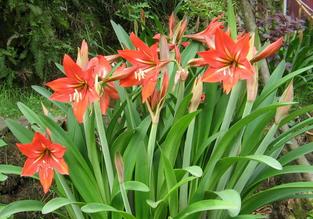
Second, Zhu Dinghong daily maintenance
The first priority of conservation is to prevent the bulbs from festering, and the second is how to grow better.
(1) about the festering of bulbs. There are often two cases of bulb fester, namely, bulb base fester and ball center fester. The former is caused by poor water absorption or bacteria in the bulb root at the initial stage of planting, while the latter is often caused by excessive water accumulation or pollution in the growth process. Compared with the former, it is easy to find and dispose of, as long as the festering area is cleaned and smeared with disinfectant and kept dry. While the latter is difficult to find and inconvenient to deal with, once it appears, the bulbs are hopeless. The best way to prevent bulb festering is to check it often and find it early. Once you find that the sphere becomes soft and the new leaves grow abnormally, you have to be vigilant.
(2) the main points of daily maintenance. It is very easy to maintain Zhu Dinghong after the dangerous period of bulb ulcers, but we should pay attention to the following points:
1. See the sunshine frequently. Although the growth of Zhu Dinghong is not strict with sunlight, it is very beneficial to the development of bulbs.
two。 Apply more phosphorus and potassium fertilizer. Zhu Dinghong is fond of fertilizer, and phosphorus and potassium fertilizer should be applied constantly throughout the year, so as to ensure the rejuvenation of bulbs. In particular, during the flower bud differentiation period in July and August every year, quick-acting phosphorus and potassium fertilizer should be applied more frequently.
3. The treatment of "clamping arrows". Zhu Dinghong will also appear the phenomenon that flowers and arrows similar to magnolia can not be fully extended and then blossom. In addition to the causes of hypoplastic development of the seed bulb itself, it can be adjusted by creating a temperature difference of 8-10 ℃ between day and night.
4. Treatment of rootless flowering. If it is found that the flower arrow is pulled out and the planting ball does not take root, the flower arrow water insert should be cut decisively at this time to prevent further consumption of the planting ball.
5. The time to remove arrows after flowers. After Zhu Dinghong flowers fade, if there is no seed, the general cultivated books are required to cut off the flowers and arrows to avoid the consumption of nutrients. However, practice has proved that it is more reasonable not to cut off the flower arrows, but only to remove the residual flowers until they are completely dry: first, flower arrows can still carry out photosynthesis and continue to produce nutrients; second, avoid pouring water into short flower arrows, causing a broken heart; third, cutting off fresh flowers and arrows will lose a lot of nutrition.
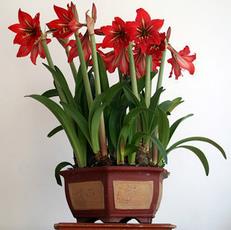
III. Prevention and control of diseases and insect pests of Zhu Dinghong
Zhu Dinghong is almost free from insect pests, and there are two common diseases: red spot disease and mosaic disease.
(1) red spot. There are light red or scarlet plaques in the affected area, which continue to expand into brown patches with red edges. After the disease, the growth of the diseased part is slow, which affects the plant growth and flowering. The disease is caused by fungi and is a common disease. It can be prevented and treated with general disinfectants, such as carbendazim, methyl thiophanate, etc.
(2) mosaic disease. The leaves of diseased plants showed faded green stripes of different length, especially in new leaves. Although the disease does not affect the growth and flowering immediately, the flowers, leaves and bulbs of the diseased plants will decrease year by year, and the rate of transmission through contact, soil and other ways is amazing. The disease is caused by a virus, and there is no effective prevention and treatment at present, which is equivalent to plant "cancer". In the initial or mild symptoms, the application of virus control agents, such as virus Bike, can be alleviated to a certain extent. The fundamental way to deal with it is to isolate the diseased strains and prevent infection.
Common problems of Zhu Dinghong seed ball
1, seed ball fester: there are two kinds of cases: ball bottom fester and ball center fester. The former is caused by poor water absorption or bacteria in the early stage of planting, and once it is found, it can be cured by cleaning up the festering place and keeping it dry after smearing disinfectant; the latter is mostly caused by excessive water accumulation in the ball center in the process of growth, once it happens, it can hardly be saved.
2. Rootless flowering: if it is found that the flower arrow has not taken root, cut off the flower arrow when the bud is scattered and not open, so as to avoid excessive nutrient consumption of the seed ball and affect the return of flowers in the coming year.
3. Remove the flowers and arrows: if no seeds are left after the flowers are withered, the residual flowers should be cut off in time, and the flowers and arrows should be kept until they are dry and then removed. In this way, you can avoid the danger of directly cutting off the flower arrow and pouring water into the short flower arrow.
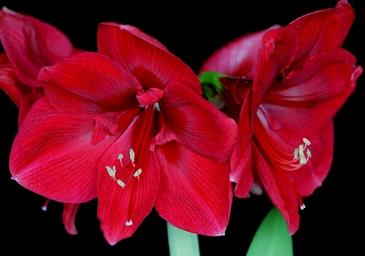
Is Zhu Dinghong toxic?
Zhu Dinghong belongs to Amaryllidaceae, and the bulbs of Amaryllidaceae all contain Lycoris and daffodils. It is advisable to keep it out of the reach of children at high places. Zhu Dinghong is a kind of flower with high ornamental value because of its colorful flowers and elegant leaves. We can't give up cultivation just because it has a little poison. In fact, many flowers are toxic, such as daffodils, jasmine, Euphorbia angustifolia, tiger thorn plum and so on. We can't stop eating for fear of choking, as long as we are careful not to touch its juice and wash our hands in time after touching it.
Can I put Zhu Dinghong indoors?
Zhu Dinghong should not put it in the sleeping room, because plants carry out photosynthesis in the sun, suck in carbon dioxide and release oxygen, and plants will need oxygen in the absence of sunlight. You can put Zhu Dinghong in the living room.
Two weeks later, it was moved to a higher temperature of 20-25 ℃ and the arrows were pulled out.
In short, some of the works done in this stage are mainly for two purposes: to prevent decay and to take root smoothly. If everything is all right, we will move on to the next step.

Second, Zhu Dinghong daily maintenance
The first priority of conservation is to prevent the bulbs from festering, and the second is how to grow better.
(1) about the festering of bulbs. There are often two cases of bulb fester, namely, bulb base fester and ball center fester. The former is caused by poor water absorption or bacteria in the bulb root at the initial stage of planting, while the latter is often caused by excessive water accumulation or pollution in the growth process. Compared with the former, it is easy to find and dispose of, as long as the festering area is cleaned and smeared with disinfectant and kept dry. While the latter is difficult to find and inconvenient to deal with, once it appears, the bulbs are hopeless. The best way to prevent bulb festering is to check it often and find it early. Once you find that the sphere becomes soft and the new leaves grow abnormally, you have to be vigilant.
(2) the main points of daily maintenance. It is very easy to maintain Zhu Dinghong after the dangerous period of bulb ulcers, but we should pay attention to the following points:
1. See the sunshine frequently. Although the growth of Zhu Dinghong is not strict with sunlight, it is very beneficial to the development of bulbs.
two。 Apply more phosphorus and potassium fertilizer. Zhu Dinghong is fond of fertilizer, and phosphorus and potassium fertilizer should be applied constantly throughout the year, so as to ensure the rejuvenation of bulbs. In particular, during the flower bud differentiation period in July and August every year, quick-acting phosphorus and potassium fertilizer should be applied more frequently.
3. The treatment of "clamping arrows". Zhu Dinghong will also appear the phenomenon that flowers and arrows similar to magnolia can not be fully extended and then blossom. In addition to the causes of hypoplastic development of the seed bulb itself, it can be adjusted by creating a temperature difference of 8-10 ℃ between day and night.
4. Treatment of rootless flowering. If it is found that the flower arrow is pulled out and the planting ball does not take root, the flower arrow water insert should be cut decisively at this time to prevent further consumption of the planting ball.
5. The time to remove arrows after flowers. After Zhu Dinghong flowers fade, if there is no seed, the general cultivated books are required to cut off the flowers and arrows to avoid the consumption of nutrients. However, practice has proved that it is more reasonable not to cut off the flower arrows, but only to remove the residual flowers until they are completely dry: first, flower arrows can still carry out photosynthesis and continue to produce nutrients; second, avoid pouring water into short flower arrows, causing a broken heart; third, cutting off fresh flowers and arrows will lose a lot of nutrition.

III. Prevention and control of diseases and insect pests of Zhu Dinghong
Zhu Dinghong is almost free from insect pests, and there are two common diseases: red spot disease and mosaic disease.
(1) red spot. There are light red or scarlet plaques in the affected area, which continue to expand into brown patches with red edges. After the disease, the growth of the diseased part is slow, which affects the plant growth and flowering. The disease is caused by fungi and is a common disease. It can be prevented and treated with general disinfectants, such as carbendazim, methyl thiophanate, etc.
(2) mosaic disease. The leaves of diseased plants showed faded green stripes of different length, especially in new leaves. Although the disease does not affect the growth and flowering immediately, the flowers, leaves and bulbs of the diseased plants will decrease year by year, and the rate of transmission through contact, soil and other ways is amazing. The disease is caused by a virus, and there is no effective prevention and treatment at present, which is equivalent to plant "cancer". In the initial or mild symptoms, the application of virus control agents, such as virus Bike, can be alleviated to a certain extent. The fundamental way to deal with it is to isolate the diseased strains and prevent infection.
Common problems of Zhu Dinghong seed ball
1, seed ball fester: there are two kinds of cases: ball bottom fester and ball center fester. The former is caused by poor water absorption or bacteria in the early stage of planting, and once it is found, it can be cured by cleaning up the festering place and keeping it dry after smearing disinfectant; the latter is mostly caused by excessive water accumulation in the ball center in the process of growth, once it happens, it can hardly be saved.
2. Rootless flowering: if it is found that the flower arrow has not taken root, cut off the flower arrow when the bud is scattered and not open, so as to avoid excessive nutrient consumption of the seed ball and affect the return of flowers in the coming year.
3. Remove the flowers and arrows: if no seeds are left after the flowers are withered, the residual flowers should be cut off in time, and the flowers and arrows should be kept until they are dry and then removed. In this way, you can avoid the danger of directly cutting off the flower arrow and pouring water into the short flower arrow.

Is Zhu Dinghong toxic?
Zhu Dinghong belongs to Amaryllidaceae, and the bulbs of Amaryllidaceae all contain Lycoris and daffodils. It is advisable to keep it out of the reach of children at high places. Zhu Dinghong is a kind of flower with high ornamental value because of its colorful flowers and elegant leaves. We can't give up cultivation just because it has a little poison. In fact, many flowers are toxic, such as daffodils, jasmine, Euphorbia angustifolia, tiger thorn plum and so on. We can't stop eating for fear of choking, as long as we are careful not to touch its juice and wash our hands in time after touching it.
Can I put Zhu Dinghong indoors?
Zhu Dinghong should not put it in the sleeping room, because plants carry out photosynthesis in the sun, suck in carbon dioxide and release oxygen, and plants will need oxygen in the absence of sunlight. You can put Zhu Dinghong in the living room.
Related
- Wuhan Hospital Iron Tree Blooming Result Was Instantly Frightened by the Gardener Master
- Which variety of camellia is the most fragrant and best? Which one do you like best?
- What is the small blue coat, the breeding methods and matters needing attention of the succulent plant
- Dormancy time and maintenance management of succulent plants during dormancy
- Minas succulent how to raise, Minas succulent plant pictures
- What are the varieties of winter succulent plants
- How to raise succulent plants in twelve rolls? let's take a look at some experience of breeding twelve rolls.
- Attention should be paid to water control for succulent plants during dormant period (winter and summer)
- Watering experience of twelve rolls of succulent plants
- Techniques for fertilizing succulent plants. An article will let you know how to fertilize succulent plants.



